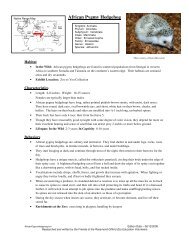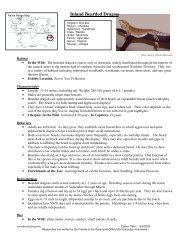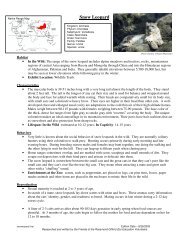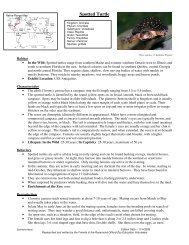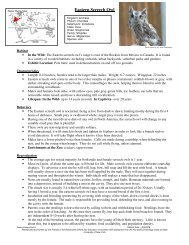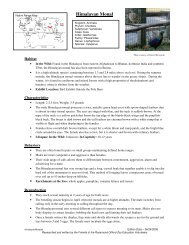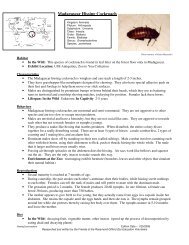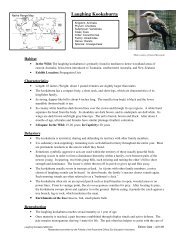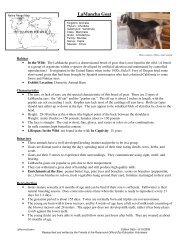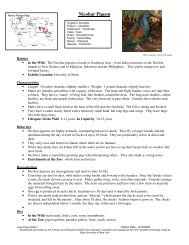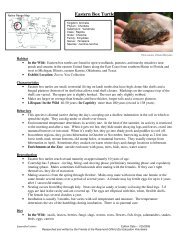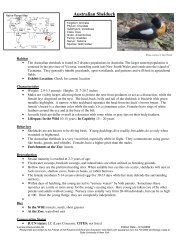Hyacinth Macaw - Rosamond Gifford Zoo
Hyacinth Macaw - Rosamond Gifford Zoo
Hyacinth Macaw - Rosamond Gifford Zoo
You also want an ePaper? Increase the reach of your titles
YUMPU automatically turns print PDFs into web optimized ePapers that Google loves.
Native Range Map<br />
<strong>Hyacinth</strong> <strong>Macaw</strong><br />
Kingdom: Animalia<br />
Phylum: Chordata<br />
Subphylum: Vertebrata<br />
Class: Aves<br />
Order: Psittaciformes<br />
Family: Psittacidae<br />
Genus: Anodorhynchus<br />
Species: hyacinthinus<br />
Habitat<br />
Photo courtesy of Lynne Panebianco<br />
• In the Wild: The geographic range of the Anodorhynchus hyacinthinus is from lower Central America<br />
to about halfway down the South American continent. The species prefers lightly forested grasslands<br />
and avoids heavily forested areas.<br />
• Exhibit Location: Social Animals<br />
Characteristics<br />
• Length: 3-4 feet; Weight: 3-3 ½ pounds; Wingspan: 40-50 inches<br />
• It is the largest species of macaw. The tail makes up half its length.<br />
• Its body feathers appear as a rich and glossy solid blue, similar to indigo.<br />
• The area around the eye and base of the lower mandible are bare with rich yellow skin.<br />
• They have short, sturdy legs with 4 toes. They have zygodactylous feet (2 toes point forward and 2 toes<br />
point backward), which are useful for hanging sideways and upside-down in trees.<br />
• The hooked beak is black and used to grasp onto trees when climbing.<br />
• Males and females are nearly indistinguishable, but the female is slightly more slender.<br />
• Lifespan: In the Wild up to 60 years; In Captivity approximately 60 – 70 years<br />
Behaviors<br />
• <strong>Hyacinth</strong> macaws are very social animals and fly in pairs or in small groups. They are most active<br />
when feeding from morning to mid-afternoon. After feeding, they return home and congregate in<br />
places called “dormitories,” which are believed to be areas of communication.<br />
• When disturbed, they screech loudly and circle overhead with their long tails streaming.<br />
• Enrichments at the <strong>Zoo</strong>: leaves, sticks, tree stumps, pine cones to investigate and play with<br />
Reproduction<br />
Diet<br />
• Anodorhynchus hyacinthinus mature at about 7 years and mate for life.<br />
• They mate once a year during the rainy season, between August and December.<br />
• Nests are built in the hollows of living or dead trees, or on the sides of cliffs.<br />
• A female will bear 1 or 2 eggs. Incubation is about 28 days.<br />
• Young macaws are fragile and vulnerable to insects and predators for their first 6 weeks.<br />
• First flight occurs at 3 months, and fledglings remain with their parents for 6 months.<br />
• In the Wild: 8 species of palm nuts, small seeds, palm sprouts, snails<br />
• At the <strong>Zoo</strong>: seeds, fruits, nuts<br />
<strong>Hyacinth</strong><strong>Macaw</strong>pwk Edition Date – 02/19/2008<br />
Researched and written by the Friends of the <strong>Rosamond</strong> <strong>Gifford</strong> <strong>Zoo</strong> Education Volunteers
Conservation Status<br />
• IUCN status: Endangered; CITES Appendix: I.<br />
• The hyacinth macaw is protected under Brazilian law and banned from export in all countries of origin.<br />
• Their numbers have been substantially reduced due to the destruction of their habitat by land<br />
development as well as by illegal hunting and trapping by humans.<br />
• Predators: eggs & young – cockroaches, ants, toucans, hawks, jays, coati<br />
adults - humans<br />
Did You Know?/Fun Facts<br />
• <strong>Macaw</strong>s are playful, inquisitive, highly intelligent and able to mimic human vocalizations.<br />
• They are able to reach flight speeds of up to 35 miles per hour.<br />
• The palm nuts that they eat are rich in fat and nutrients. The nutshells are quite hard so the bird uses its<br />
beak to crack the shell and cleanly break it in half. Although most feeding occurs on the ground, they<br />
have the ability to pick palm nuts from clusters hanging on trees. They have also been known to eat<br />
palm nuts that have passed through the bowels of cattle.<br />
Sources:<br />
• Attenborough, D. (1998). The life of birds. Princeton, NJ: Princeton University Press.<br />
• Busch Entertainment Corporation, <strong>Hyacinth</strong> macaw. Retrieved October 19, 2007, from<br />
SeaWorld/Busch Gardens ANIMALS Web site: www.seaworld/org/animal-info/animalbytes/animalia/eumetazoa/coelommates/deuterostomes/chordata/craniata/aves/psittaciformes/hyacinthmacaw/html<br />
• Clark, W. To other macaws. Retrieved April 30, 2007, from Foundation for the Preservation of<br />
<strong>Hyacinth</strong> <strong>Macaw</strong>s Web site: http://www.hyacinthmacaw.org/hyacinthmacaw.htm<br />
• Forshaw, J. (Ed.). (1998). Encyclopedia of birds. San Diego, CA: Academic Press.<br />
• Hagan, E. 2004. “Anodorhynchus hyacinthinus” (On-line), Animal Diversity Web. Accessed April 30,<br />
2007 at http://animaldiversity.ummz.umich.edu/site/accounts/information/Anodorhynchus<br />
_hyacinthinus.html.<br />
• Levine, E. and H. Chick. (2003, April 30). <strong>Hyacinth</strong> macaw: andorhynchus hyacinthinus. Retrieved<br />
April 30, 2007, from Earlham College Web site:<br />
http://www.earlham.edu~chickha/hyacinth/hyacinth.htm<br />
<strong>Hyacinth</strong><strong>Macaw</strong>pwk Edition Date – 02/19/2008<br />
Researched and written by the Friends of the <strong>Rosamond</strong> <strong>Gifford</strong> <strong>Zoo</strong> Education Volunteers



